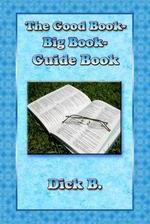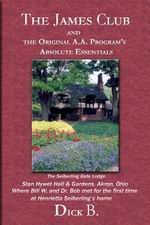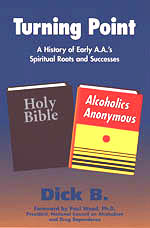Other Books Written by Dick B. that were Published
Dick’s books can be ordered from many major online book retailers.
CONTINUED – BOOKS 22 THRU 26
|
ISBN
1-885803-91-5  |
The Good Book-Big Book Guidebook You don’t need to leave A.A. or any 12 Step program or even a treatment program just because you are a Christian. Nor do you need to flee to an exclusively Christian Fellowship, Christian Treatment Program, or Christian Track Program just to believe or profess your beliefs in connection with your own recovery. You’re the boss. You need all the help you can get. We’ve long needed a guide that will use history to help you in your recovery—whatever your choice of fellowships, groups, recovery programs, or treatment programs. Early A.A.’s Christian Fellowship— with its emphasis on reliance on our Creator, acceptance of Christ, Bible study, prayer, guidance, fellowship, and witness—is nothing to be buried, to be hushed up, or to be afraid of mentioning. It’s a part of recovery history—the most important part, the part that set A.A. aside in the 1930’s as a cure for the medically incurable, an alternative to medicine, hospitalization, and clergy dominated ideas. It embraced them all, but struck out for the importance of a Society that took these ideas and let drunks be the message carriers. You can do this too and probably better if you know your history. Include this guide book in your reading. Include it in your recovery. Include it in your fellowship or group. Include it with any other recovery program, secular, Christian, or rational. It’s history. It tells you what worked. It tells you how you can choose to use it today if you wish. It will help you understand words and phrases and ideas that came from historical roots. And it doesn’t bash other ideas or fellowships. It seeks to inform all and urge them to include history in their curriculum. This is a guide to history that has not been used before. It’s a guide that will supplement and not replace. It’s a guide for you!
|
|
ISBN
1-885803-99-0  |
THE JAMES CLUB AND THE ORIGINAL A.A. PROGRAM’S ABSOLUTE ESSENTIALS For years, A.A. has quietly acknowledged, primarily through one publication, that the early A.A. pioneers in Akron believed firmly that the answer to all their problems was in the Good Book, as they called the Bible. A.A. co-founder Dr. Bob said that all the basic ideas were taken from their study of the Good Book. And he added many many times that the three parts of the Bible the old-timers considered “absolutely essential” to their spiritual program of recovery were: (1) The Book of James. (2) Jesus’s Sermon on the Mount, found in Matthew Chapters 5, 6, and 7. (3) 1 Corinthians 13, Paul’s famous chapter on “love.” You can find the foregoing remarks in A.A.’s DR. BOB and the Good Oldtimers, in pamphlets published by Akron AA, and in several talks given through the years by Dr. Bob himself. And it was even his co-founder friend Bill Wilson who spoke of the studies of James, the Sermon, and Corinthians; the reading of these passages by Dr. Bob’s wife Anne to Bill and Bob; and the fact that—as Bill put it—“James was our favorite.” And he added that many favored calling the A.A. fellowship “The James Club.” All this and much much more is detailed in Dick B.’s 25th published title on the Biblical roots of Alcoholics Anonymous. But this title offers a great deal more. In three major parts, it provides a detailed framework for studying each of the three Bible parts—just as the A.A. pioneers did. The reader can sit with his Bible open beside him, his Big Book available for reference, and Dick’s The James Club title before him. He, the newcomer, and others individually or as a group can study each of the three parts, digest their messages, compare with the A.A. program and its ideas, and then apply these biblical truths in daily life, in practicing the Twelve Steps, and in understanding the miracles that the Creator Yahweh wrought when the pioneers read and believed! Each of the three parts carries a special message, though all three fit together. Bill W. and Dr. Bob both said that the Sermon on the Mount contained the underlying philosophy of A.A.—perhaps embodying the Golden Rule (“do unto others as you would have them do unto you”). And Dick’s title explores just how each verse in Matthew illustrates the way in which Jesus said his followers were to “do the will” of his father which is in heaven. You’ll see the many parts of the Sermon that were adopted into the A.A. Steps and Big Book language and ideas. The title begins with the Book of James, however. Dick details why it has primacy in the study—based in part on its being the AAs’ favorite and in part on the ease with which it can be read and understood. Yet the meat of this wonderful book lies in its explicit formula for a cure—especially the cure of the alcoholic. James speaks of patience. He speaks of enduring temptation. He speaks of seeking God’s wisdom without doubting. He speaks of temptation as the enticement which turns into sin and finally death. He strongly suggests that the readers be “doers of the word (the Bible) not hearers only, deceiving themselves. He spells out what “doing” the Word is. It’s about action; it’s about following the “royal law” of loving thy neighbor; its about benevolent giving without respect of persons and with specific aim at the downtrodden; it’s about backing up one’s “faith” with deeds—“works” as James called them; it’s about guarding the tongue and guarding the thoughts and guarding the actions so that devilish thoughts and impulses do not take over; and finally it’s about the importance of prayer, confession of faults and the Lord’s forgiveness, and about prayer for healings. In a nutshell, this book summarizes the whole pioneer approach in Akron; and, of course, it has nothing to do with “steps” or a “basic text” or the “Oxford Group.” It’s about God’s healing ministry, as A.A. old-timer Clarence Snyder put it. Then there’s the Thirteenth Chapter of First Corinthians. Its relationship to Henry Drummond’s famous treatise and best-selling book The Greatest Thing in the World is made clear to you. It lays out the nine ingredients (as Drummond called them) of love, and illustrates that one can have the power (spoken of in the preceding 12th chapter) and the application (spoken of in the following 14th chapter) and still have nothing—if not accompanied by the love of God in the renewed mind in manifestation. It concludes that there are faith, hope, and love; but the greatest of these is love.” You’ll wind up, as Dr. Bob did after 10 years of sobriety, believing that the fundamentals (as he called them) in these three segments will heal you, enlighten you, change you, and make your life the kind of life—the abundant life—that Jesus came to teach about and make available. To sum up, there are five valuable appendices. The first gives you explicit details on the early A.A. program in Akron. The second explains its roots in United Christian Endeavor and just what the almost-forgotten Christian Endeavor movement taught Dr. Bob and enabled him to bring to the table. The essence was, in Christian Endeavor, as it was seen by Dr. Bob himself. Love and Service. The third appendix explains the vital difference between the Akron program, its founder, and its roots, and the program fashioned four years later by Bill in his Big Book. The fourth dives into the Book of James—its history, its canonical standing, and its author; for James was held, by most, to be the brother of Jesus and the author of the book. The final appendix illustrates how important it is to look to the Bible itself for information about God, Yahweh our Creator. Such information readily builds the readers’ believing and expunges the idea that the false gods in today’s recovery talk have anything to offer but the wrath of God Himself.
|
|
ISBN
1-885803-19-2  |
THE OXFORD GROUP & Scholarly, comprehensive, unique! A.A. was an integral part of the Oxford Group in the early 1930’s, and this book contains the only study of the Oxford Group’s contributions to early A.A.’s Big Book, Twelve Steps, and Fellowship. You will find here the Oxford Group’s Biblical roots, the origin of its ideas, details on its beliefs and practices, its influence on early A.As and their high success rate, and where its concepts can be found in today’s A.A. Foreword by Rev. T. Willard Hunter; author, columnist, Oxford Group activist; former Assistant to the President of the School of Theology at Claremont, California.
|
|
ISBN
1-885803-07-9  |
TURNING POINT Turning Point contains a comprehensive history of early A.A.’s spiritual sources and successes. It is a title six years in the making. Here you will see the specific roots of, and details about, early A.A.’s spiritual recovery principles. You will learn exactly what the Twelve Step pioneers borrowed from: (1) the Bible; (2) Rev. Sam Shoemaker’s teachings; (3) the Oxford Group; (4) the Christian literature early AAs read; (5) the study and quiet time sessions conducted by Dr. Bob’s wife Anne; and (6) their meditation periodicals and books, such as The Upper Room, My Utmost for His Highest, and The Runner’s Bible. Early A.A. had an astonishing success rate with “medically incurable” pioneers who really tried. The rate was somewhere between seventy-five percent (75%) and ninety-three percent (93%) in the Midwest. Most early AAs relied on the power of God for their recoveries. And Turning Point gives you practical suggestions for today, enabling you to understand, recover with, and grow spiritually in, the very biblical ideas that Twelve Step pioneers used in the 1930’s and early 1940’s to achieve their unique successes in overcoming alcoholism and the problems it causes. Foreword by Paul Wood, President, National Council on Alcoholism and Drug Dependence, Inc.
|
|
ISBN
1-885803-98-2  |
TWELVE STEPS FOR YOU How do I take Twelve Steps in A.A. or any other12 Step Fellowship? How do I work those Steps? How do people practice the 10th, 11th, and 12th Steps? And how many times have you heard these questions asked – with no simple, complete answers? Author Dick B. has spent thirteen years researching the roots of Alcoholics Anonymous, its Big Book, its Twelve Steps, and the way in which these were developed. And now, he presents a group of simple instructions based on the history of Alcoholics Anonymous, the contributions of its founders, and the ideas of its predecessors. In just a few pages, you can learn what the “Twelve” ideas were in Bill Wilson’s mind, in the practices of the pioneers in Akron, in the so-called “six steps” in Bill’s word-of-mouth summaries, in the journal kept by Dr. Bob’s wife Anne Smith, in the teachings and writings of Bill’s spiritual mentor Rev. Samuel Moor Shoemaker, Jr. of Calvary Church in New York, in the life-changing program of the Oxford Group from which A.A. sprang, and in the Bible – from which all of the basic ideas were borrowed. More still, you will see how to take the Steps in accordance with the instructions in A.A.’s Big Book, how to understand each Step in terms of its historical roots, and how you can understand the Steps far better if you see how they fit into the A.A. spiritual concepts of “finding God,” “reliance on the Creator,” “establishing a relationship with God,” and practicing the principles of the Bible as they found their way into the principles of the 12 Step program. Long needed, this simple tool meets the requests of clergy, sponsors, counselors, therapists, facilitators, and those wanting accurate, helpful guidance from the Bible, A.A.’s founders, and A.A.’s Big Book. Dick B. is a hands-on AA. He has long been active in the program, gone to Big Book Seminars, attended thousands of meetings and conferences, conducted history programs, and sponsored almost 100 men and women in their recovery. He knows the questions. He researched the answers. He passed them on to those in need. And now he presents them for you. |
